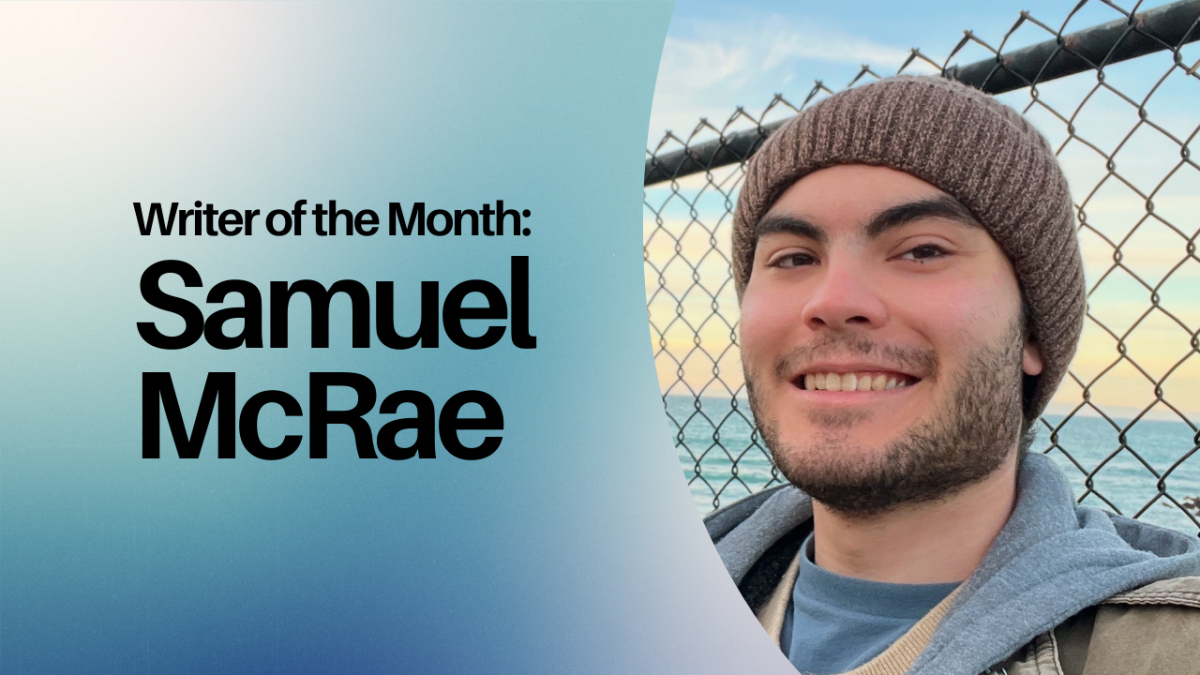You’ll likely spot our next writer gathering moss or tackling a four-mile hike. As a literature and writing studies major with a minor in biology, Samuel McRae has always had a fascination with nature and stories.
“Writing is accessible,” McRae said. He thinks writing can be “private” while placing us in community, remarking on how storytelling is an intrinsically human way of understanding the world.
From writing to nature, McRae has always been interested in understanding the world he lives in.
“It was natural disasters as a kid,” he says, “I used to be heavily fixated on tornadoes, volcanoes, tsunamis, floods, cyclones, hurricanes. Eventually, that passion for nature shifted to animals.”
In high school, McRae’s biology classes started unlocking more questions and answering ones he had previously. In the past few years, McRae has been involved with restoration efforts in Tecolote Canyon where he returned many native species to the land.
“It’s a tangible way to aid the people and the land as climate change sets in, set it up for a better future, for forever, for as long as they have,” McRae said.
This writer has a clear love for the environment which is expressed through his tone, easy smile, and inquisitive nature.
“It’s fascinating how life evolves and continues to adapt,” he remarks.
Story Feature: Coyote Lens
In McRae’s first published short story, Coyote Lens, he brings his love for nature while playing with the “Karen” stereotype, which depicts a rude middle-aged white woman who addresses others as beneath her. McRae’s “Karen,” who is named Karime (KAAR-ih-meh) is Hispanic, married to a woman, and fiercely protective of her surroundings.
Throughout the story, many characters view Karime as erratic and rash, despite her purposeful and intentional actions. McRae ties this to Karime’s gender and gender expression, mentioning the stereotypes butch women face—aggressive, stoic, and emotionless. McRae contrasts and parallels butch stereotypes to the “Karen” stereotype, calling attention to the different ways sexism presents itself.
“I didn’t explicitly describe where Karime and [her wife] Ana fall under the rainbow, but I did enjoy writing these two butch women,” McRae notes.
McRae is interested in disrupting stereotypes and portraying characters who have a love of their surroundings in his writing. He also believes Karime is a character who can see the world from outside a human lens which makes her a powerful perspective to consider.
What are Mccrae’s influences?
“Gathering Moss” by Robin Wall Kimmer guided McRae’s intentional journey of paying attention to the land. He trained his eyes to see certain plants and birds.
“The Space Between Worlds” by Micaiah Johnson shaped McRae’s view of science fiction. He appreciated the world building, meticulous plotting, and political overtones embedded in the book’s power structures. He notes the real power science fiction has to reflect the world and predict the future.
McRae also notes his family:
“I aspire to be the well-informed competent man that my dad is,” he says. “My mom is very understanding and strong. I have two siblings: Michael and Sarah. Shout out to them, they’re awesome.”
To the Future:
McRae is currently working on a story about a living boat, hoping to send it to a horror publication.
“The crew functions the same way our gut bacteria or organelles do,” he says, referencing an idea he brewed with his friend, “Boats are very personified. You refer to boats as she.”
Look out for more writing from Samuel McRae and all CSUSM student writers.
If you are interested in being the next Writer of the Month, please fill out this form or email Saturn Salama at [email protected].
(This article is part of an ongoing series about student writers at CSUSM, created to center their unique artistry as storytellers. Any form of storytelling is key to community and the Chronicle’s Writer of the Month opens student stories to all CSUSM students and staff, not just those studying literature and writing.)


